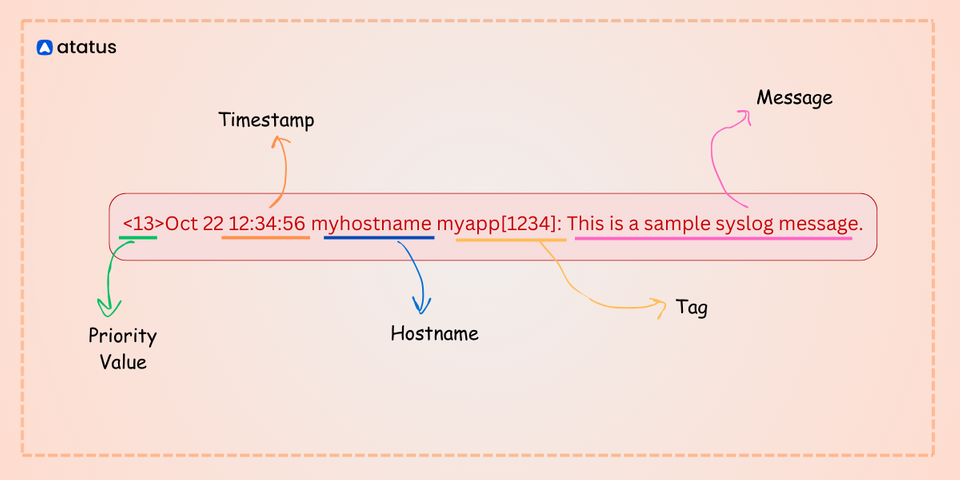Understanding Syslog Formats: A Comprehensive Guide
Syslog, short for System Logging Protocol, is a standard protocol used to send log messages and event notifications across a network. It plays a crucial role in monitoring and managing the health, performance, and security of systems and applications.
Syslog was originally developed as a part of the BSD operating system, but many other operating systems and network devices have since adopted it. One of the key aspects of syslog is its flexible and standardized message formats.
Syslog is employed in various cases, including network device monitoring, security information and event management (SIEM), troubleshooting system issues, and auditing.
In this article, we will explore the various syslog formats, their components, and their significance in the world of system logging. Before we dig into Syslog Formats, let’s learn the basics of Syslog first!
Table Of Contents:
Syslog Basics
Syslog is a standardized protocol used for the collection and forwarding of log messages and events in a network. It is commonly implemented in Unix and Unix-like systems, but it is also widely supported on other platforms. Syslog is essential for monitoring, troubleshooting, and maintaining the health and security of systems.
Syslog operates on a client-server model, where the client is responsible for generating log messages, and the server receives, stores, and forwards these messages. The syslog messages contain important information such as the facility, severity level, timestamp, and the actual log message.
Syslog configuration involves setting up the syslog server to listen for incoming messages and configuring clients to send their logs to the server. Configuration files, such as /etc/syslog.conf or /etc/rsyslog.conf, specify how syslog messages should be processed.
Understanding syslog basics is crucial for system administrators and IT professionals who need to monitor and manage the health and security of their systems.
Syslog Message Components
Before diving into different syslog formats, let's understand the basic components of a syslog message:
- Priority (PRIVAL): A numerical value that combines the facility and severity level of the message. It is enclosed in angle brackets (< >).
- Timestamp: Indicates the time when the message was generated. It is typically in the format of MMM DD HH:MM:SS (month, day, hour, minute, second).
- Hostname: Identifies the origin of the syslog message, indicating the system or device that generated the log.
- Tag: Tag or Process ID represents the application or process that generated the message. It is often user-defined.
- Message: The actual log information or event description.
Syslog Formats
The syslog format refers to the structure and layout of log messages that are generated and transmitted using the Syslog protocol. Syslog is a standard protocol used for sending log messages and event notifications across a network. It is commonly employed in Unix and Unix-like systems but is also supported by many other platforms.
1. Syslog Protocol (RFC 3164)
This format is defined by RFC 3164 and is one of the earliest standards for syslog messages. It is a plaintext format with a human-readable structure. A typical RFC 3164 syslog message looks like this:
<PRIVAL>TIMESTAMP HOSTNAME TAG: MESSAGEExample:
<13>Oct 22 12:34:56 myhostname myapp[1234]: This is a sample syslog message.In this example:
- 13 is the priority value (facility 1, severity 5).
- Oct 22 12:34:56 is the timestamp.
- myhostname is the hostname.
- myapp[1234] is the tag, indicating the application and process ID.
- This is a sample syslog message. is the log message.
2. Syslog Protocol (RFC 5424)
As an improvement over RFC 3164, RFC 5424 introduces a more structured and extensible syslog message format. It uses a combination of key-value pairs for flexibility. The timestamp is also in a standardized format, making it easier to parse and interpret across different systems. The enhanced structure of RFC 5424 is designed to address some limitations of the earlier syslog formats, providing a more modern and extensible approach to log messages. A sample RFC 5424 syslog message looks like this:
<PRIVAL>VERSION TIMESTAMP HOSTNAME APP-NAME PROCID MSGID [STRUCTURED-DATA] MESSAGEExample:
<165>1 2003-10-11T22:14:15.003Z myhostname myapp 1234 ID47 - [exampleSDID@32473 iut="3" eventSource="Application" eventID="1011"] An application event log entry...Breaking down the components:
- <165>: Priority value, where 165 is the combination of facility (16) and severity (5).
- 1: Version number of the syslog protocol being used.
- 2003-10-11T22:14:15.003Z: Timestamp in the format of ISO 8601.
- myhostname: Hostname identifying the system or device that generated the log.
- myapp: Tag indicating the application or process that generated the message.
- 1234: Process ID (PID) of the application.
- ID47: Message ID.
- -: Structured data field is optional and absent in this example.
- [exampleSDID@32473 iut="3" eventSource="Application" eventID="1011"]: Structured data providing additional information in a key-value pair format.
- An application event log entry...: The actual log message or event description.
3. Syslog over TCP/TLS (RFC 6587)
RFC 6587 defines the syslog protocol over TCP (Transmission Control Protocol) with support for Transport Layer Security (TLS). The syslog messages transmitted using this protocol have additional framing information to accommodate the reliable and secure nature of TCP/TLS transport.
Example:
<165>1 2013-02-01T09:00:00.000Z myhostname myapp 1234 ID47 [exampleSDID@32473 iut="3" eventSource="Application" eventID="1011"] An application event log entry...4. Syslog Protocol (RFC 5425)
Building on RFC 5424, RFC 5425 defines the syslog protocol over a secure transport layer (TLS). It enhances the security of syslog communication, crucial for transmitting sensitive log data.
Example:
<165>1 2013-02-01T09:00:00.000Z myhostname myapp 1234 ID47 [exampleSDID@32473 iut="3" eventSource="Application" eventID="1011"] An application event log entry...This example is similar to the one provided earlier for RFC 6587 over TCP/TLS.
The components are the same, including the priority value, version number, timestamp, hostname, application tag, process ID (PID), message ID, structured data, and the log message. The key distinction is that RFC 5425 focuses on the secure transport of syslog messages using TLS.
In RFC 5425, the transport layer security (TLS) ensures the confidentiality and integrity of syslog messages during transmission over the network. This is particularly important when transmitting sensitive or private log data.
The framing information within the syslog messages allows the server to identify message boundaries, ensuring proper parsing and interpretation, even when using a secure transport layer.
Keep in mind that RFC 5425 is specifically designed for secure syslog transport, and it requires both the syslog sender (client) and syslog receiver (server) to support TLS for encrypted communication.
Choosing the Right Syslog Format
The choice of syslog format depends on factors such as compatibility, security requirements, and the level of detail needed in log messages.
Choosing the right syslog format depends on various factors, including compatibility, security requirements, and the level of detail needed in log messages. Here are some considerations to help you decide:
1. Compatibility:
- RFC 3164 (Traditional Syslog): This format is widely supported and understood by many systems. If compatibility with a broad range of devices and applications is a priority, RFC 3164 may be a suitable choice.
- RFC 5424 (Structured Syslog): If you are working in a more modern environment or with systems that support the extended features of RFC 5424, it might be a better fit.
2. Structured Data Requirements:
- RFC 3164 - Traditional syslog does not have a standardized structured data field. If you require a more structured and extensible format for additional contextual information, RFC 5424 with its structured data field may be preferable.
3. Security:
- RFC 5425 (Syslog over TLS): If security is a top priority, especially when transmitting log messages over a network, consider using the secure transport capabilities defined in RFC 5425. This ensures confidentiality and integrity through the use of TLS (Transport Layer Security).
4. Transport Protocol:
- RFC 5424 (Syslog Protocol): If you need a reliable transport mechanism, especially for message integrity and sequencing, consider using syslog over TCP (RFC 5424) instead of the traditional UDP. For even greater security, use syslog over TLS (RFC 5425).
5. Ease of Parsing:
- RFC 3164: Traditional syslog messages are human-readable and easy to parse. If your primary concern is simplicity and ease of parsing, RFC 3164 may be more suitable.
- RFC 5424: Structured syslog provides a more standardized format, making it easier to parse machine-generated logs programmatically. This can be beneficial for automated log analysis and monitoring systems.
6. Log Detail and Extensibility:
- RFC 5424: If you need more detailed log messages with extensible key-value pairs and a structured format, RFC 5424 is a better choice. It allows for a richer set of information in the syslog messages.
Conclusion
Syslog plays a fundamental role in the management and monitoring of systems, and understanding its various formats is essential for effective log analysis and troubleshooting.
Whether you opt for the simplicity of RFC 3164 or the enhanced capabilities of RFC 5424, choosing the right syslog format ensures that you can efficiently collect, parse, and interpret log messages for maintaining the health and security of your systems.
The choice of syslog format may depend on factors such as the level of detail needed, compatibility, and security requirements. It's important to evaluate the capabilities and limitations of each syslog format in relation to your system architecture and logging needs.
Atatus Logs Monitoring and Management
Atatus offers a Logs Monitoring solution which is delivered as a fully managed cloud service with minimal setup at any scale that requires no maintenance. It monitors logs from all of your systems and applications into a centralized and easy-to-navigate user interface, allowing you to troubleshoot faster.

We give a cost-effective, scalable method to centralized logging, so you can obtain total insight across your complex architecture. To cut through the noise and focus on the key events that matter, you can search the logs by hostname, service, source, messages, and more. When you can correlate log events with APM slow traces and errors, troubleshooting becomes easy.
#1 Solution for Logs, Traces & Metrics
APM
Kubernetes
Logs
Synthetics
RUM
Serverless
Security
More



